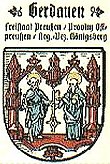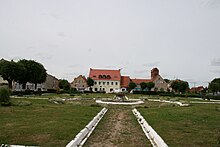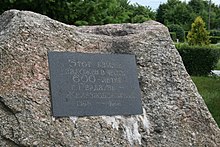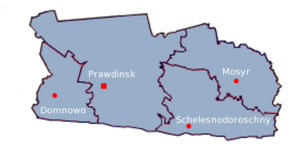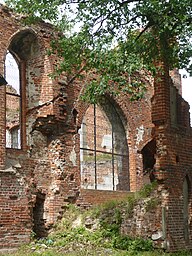Schelesnodorozhny (Kaliningrad)
| Urban-type settlement
Schelesnodoroschny
Gerdauen Железнодорожный
|
||||||||||||||||||||||||||||||||||||
|
||||||||||||||||||||||||||||||||||||
|
||||||||||||||||||||||||||||||||||||
Schelesnodoroschny ( translit. Železnodorožnyj, Russian Железнодорожный ; German until 1947 Gerdauen ; Prussian Gierdawen ; Polish Gierdawy ) is a place in the Russian Oblast Kaliningrad with 2,767 inhabitants (as of October 14, 2010). The urban-type settlement is part of the Pravdinsk municipal self-government unit .
Geographical location
The place is located in the historical region of East Prussia , on the west bank of the small river Omet and Lake Banktin , about 71 kilometers southeast of Königsberg ( Kaliningrad ). The Polish border runs three kilometers to the south .
The Russian trunk road A 196 runs through Schelesnodoroschny and runs from Königsberg via Friedland ( Prawdinsk ) to the Russian-Polish border at Nordenburg ( Krylowo ). A side road from Allenburg ( Druzhba ) joins the town and follows the route of the former Reichsstraße 141 .
In 1871 the former Gerdauen was connected to the Thorn – Insterburg railway line , and in 1901 it was connected to the railway line from Königsberg (Prussia) via Löwenhagen to Angerburg . In 1917, operations on the Rastenburger Kleinbahnen line from Barten to Gerdauen began. All three railway lines are no longer used; the last line to Chernyakhovsk was shut down in 2001.
Place name
The city name Gerdauen, which was valid until 1947, is derived from the Prussian tribal chief Girdawe . He was the son of the Prussian noble Tulegarde from the Rendalia family, who converted to the Christian faith with his father and owned a castle here in 1260. The name Girdawe should be derived from the Prussian girdin and mean something like "speak", "talk", "keep word".
The Russian place name Schelesnodoroschny, formed from schelesny = iron, and doroschny = road, means in German about railway town.
history
Around the middle of the 13th century the Prussian leader Girdawe, whose name means spokesman , owned a castle on a hill on the river Omet. During the Prussian uprising against the Teutonic Order in 1262, Girdawe refused to fight the Order's army, burned down his castle and went to Königsberg under the protection of the Order . Under the command of Heinrich von Eysenberg, the Teutonic Order built a new castle in place of the former Prussian castle in 1325 to protect against the Lithuanians . They besieged the castle in 1347, but could not take it. In 1368, in connection with the mention of the castle lord Kuno von Hattenstein, Gerdauen was mentioned as the name of the castle, which was obviously derived from Girdawe the Prussian leader. Under Grand Master Winrich von Kniprode , the area around the castle was settled with German immigrants from the middle of the 14th century. On September 21, 1398, Grand Master Konrad von Jungingen granted Gerdauen the city charter in Kulm . Soon afterwards the city was given a defensive wall and the construction of a church began. In 1428 the Dominican monastery in Nordenburg was relocated to Gerdauen.
When the Teutonic Order got into financial difficulties after the Second Peace of Thorner , its Grand Master Heinrich Reuss von Plauen pledged Nordburg and several villages as well as Gerdauen and its castle to the brothers Georg and Christoph von Schlieben , who later became hereditary owners . A city fire in 1485 caused great damage, which was only repaired after eight years. After the Reformation had prevailed in Prussia, the Dominican monastery in Gerzeit was dissolved around 1530 .
After the formation of the Kingdom of Prussia in 1701, Gerdauen became part of the Rastenburg district . The Prussian King Frederick I . 1708 granted Gerdauen the right to hold four annual fairs.
Around the time when the Battle of Groß-Jägersdorf took place in the summer of 1757 during the Seven Years' War (1756–1763) , a group of Cossacks tried to get into the town of Gerdauen, the gates of which had been closed, but were scared off by a vigilante group. The Cossacks then contented themselves with plundering the castles of the Counts Schlieben and other places in the area.
In the course of the reorganization of the administrative structure of Prussia after the Congress of Vienna , Gerdauen became the district town of the district of the same name on February 1, 1818 . The modern traffic routes of the 19th century first reached the city in 1858 with the new Chaussee to Angerburg. In 1871 it was connected to the Thorn – Insterburg line, a line to Königsberg was opened in 1898, and a small railroad began operating in 1917. Due to the favorable transport connections, Gerdauen became an important center of the grain trade, there was also a cloth manufacture and a tannery. The population had increased from 2,858 in 1890 to 4,578 in 1910.
During the First World War numerous houses were destroyed by fighting near Gerdauen in September 1914. With the help of the sponsored cities of Budapest and Berlin-Wilmersdorf , the reconstruction, in which well-known architects such as Heinz Stoffregen , Otto W. Kuckuck and Hugo Wagner participated, could be completed in the "old German" style by 1921. In 1939 the number of inhabitants had increased to 5,125. The Second World War did relatively little damage in Gerdauen.
The Gerdauen airfield was built in 1938/39 and was in operation until 1945. An external labor camp of the Stutthof concentration camp was located in Gerdauen .
On January 27, 1945 Gerdauen was occupied by the Red Army . On July 15, 1945, a document was signed in a Polish-Soviet agreement, according to which the Soviet military authorities transferred the city to the Polish civil authorities. The town, now called Gierdawy , was the seat of the Polish district administration for the entire district of Gerdauen until August 16, 1945, but this was then moved to Skandau , ten kilometers to the south . On September 4, 1945, the Polish administration was informed in writing that they and the Polish civilian population who had already immigrated had to leave the city, as Gerdauen, as well as the entire northern part of the district, were again placed under Soviet administration. Originally it was apparently intended that Gerdauen, like the entire district, should be incorporated into the Polish state. Contrary to these plans, however, the Soviet Union moved the border to the south at the expense of the Polish state, so that the entire urban area became part of the Soviet Union . The now common Polonized place name Gierdawy was deleted again and the city was named in Gerdauen for the last time .
The city became part of the Soviet Kaliningrad Oblast. In 1947 the place was renamed Schelesnodoroschny, whereby it lost its town charter and has since had the status of an urban-type settlement . Even after the German population fled and were expelled, the place was initially well preserved, but the new border location made further development difficult. From 1947 to 1962, Schelesnodorozhny was the administrative seat of the Schelesnodorozhny Rajons . The city began to decline in the 1960s. A significant part of the old building has been destroyed since then, and the church is now just a ruin. From 2004 to 2015 Zheleznodorozhnoye was the seat of an urban municipality and has been part of the Pravdinsk district since 2016.
For the 600th anniversary of the town of Schelesnodoroschny / Gerdauen, a memorial stone was unveiled in 1998 on today's market square, which also bears the German name Gerdauen in Cyrillic script.
Zheleznodorozhnye gorodskoje posselenie 2004–2015
The urban municipality of Zheleznodorozhnye gorodskoje posselenije (ru. Железнодорожное городское поселение, Zeleznodorozhnoye gorodskoje posselenije) was established in 2004 as a possessed area of the Russian Sholavsky township: Possessedodorosnosky settlement of the Russian-Sholavsky type in the year 2004: Possessed odorosnostny in the Russian area of the 30th Russian settlement.
In addition to the "urban-type settlement" Schelesnodorozhny, the following 30 settlements belonged to the Schelesnodoroschnoje gorodskoje posselenije:
| Place name | German name | Place name | German name | |
|---|---|---|---|---|
| Aivazovskoye (Айвазовское) | Trausen (forest house) | Novo-Biyskoye (Ново-Бийское) | Friedrichswalde | |
| Kholmogorje (Холмогорье) | Peißnick with Gneisenau, Mühling, Partsch and Wisdehlen | Novosjolki (Новосёлки) | Neuendorf | |
| Gogolevskoje (Гоголевское) | Althof | Novostrojewo (Новостроево) | to Gerdauen | |
| Grebnoje (Гребное) | Grünhagen | Oserki (Озерки) | Georgenfelde | |
| Kamenka (Каменка) | (Large) pentlack | Panfilowo (Панфилово) | Klonofken / Dreimühl | |
| Klenowoje (Кленовое) | Grueneberg | Zarechenskoye (Зареченское) | Great Sobrost | |
| Kostromino (Костромино) | Grünheim with Großheim | Shevtsovo (Шевцoво) | Plikow / Plickau | |
| Kochkino (Кочкино) | Popowken / Neusobrost | Smolnoje (Смольное) | Charlottenburg | |
| Kochubejewo (Кочубеево) | Agonken / Altsiedel | Znamenka (Знаменка) | Klinthenen | |
| Krylowo (Крылово) | Nordenburg | Sowchosnoje (Совхозное) | Christinenfeld | |
| Krymskoje (Крымское) | Pre-lacquer | Zverevo (Зверево) | Wall paints | |
| Lipnjaki (Липняки) | Mourning | Tschaadajewo (Чаадаево) | Brolost | |
| Mikhailovka (Михайловка) | Linden tree | Tchaikino (Чайкино) | Noise | |
| Nekrasovka (Некрасовка) | Nordenthal | Vishnevoe (Вишнёвое) | Altendorf | |
| Nikitino (Никитино) | Bawien / Bauden | Wolnoe (Вольное) | Wolla / Ebenau |
Population development
| year | Residents | Remarks |
|---|---|---|
| 1782 | over 1,600 | |
| 1831 | 2,096 | |
| 1875 | 2,864 | |
| 1885 | 2,887 | |
| 1890 | 2,858 | including 30 Catholics and 55 Jews |
| 1910 | 4,578 | |
| 1933 | 4,712 | |
| 1939 | 5.125 | |
| 1959 | 3,380 | |
| 1970 | 3,661 | |
| 1979 | 3,772 | |
| 1989 | 3,246 | |
| 2002 | 2,945 | |
| 2010 | 2,767 |
Note: census data
church
Church building
Former parish church
The Gerdauen parish church was originally built as a fortified church, founded in 1260 by the Prussian Girdawe, who converted to Christianity .
The north wall of the church was later integrated into the city wall , and the fortified tower was reinforced with buttresses .
The church, which can still be seen today in its ruins, dates from the first half of the 15th century. It is a brick building without a choir , presumably by the same master builder as the church in Löwenstein (now Polish: Lwowiec), who created the remarkable stepped gable on the east side.
In 1696 the church was severely damaged by lightning. A devastating fire raged in 1913, and in 1914 the top of the tower was destroyed by fire. Again and again all damage was repaired and the building stock was secured through renovations.
The church was spared from destruction during the Second World War . In the years 1948 to 1957 the building was repurposed and used as a cultural center . After that it was left to decay and vandalism. In the 1970s the roof and part of the east gable collapsed, and in 1988 the gable above the south porch. After 1992, urgently necessary safety and restoration work was carried out - also with help from Germany - and the tower has been protected since 1998. It has not yet been decided whether the building can be returned to its original purpose as a place of worship.
Peter and Paul Church
The Russian Orthodox Peter and Paul Church has existed since 2010.
Evangelical parish
Church history
Since the Reformation the church in Gerdauen has been a Protestant parish church for a large parish . Until 1945 the city and the surrounding area were dominated by a predominantly Protestant population. The parish was part of the Gerdauen church district within the church province of East Prussia of the Evangelical Church of the Old Prussian Union until 1945 and was looked after by two clergymen.
After 1945, as a result of flight and displacement, church life came to a standstill if it did not occasionally take place in a private setting. It was not until the 1990s that Protestant congregations emerged again in Kaliningrad Oblast, which is now part of Russia . The closest community to Zheleznodorozhny is that in Pravdinsk . It belongs to the ecclesiastical region of the Church of the Resurrection in Kaliningrad within the also newly founded Provosty Kaliningrad of the Evangelical Lutheran Church of European Russia (ELCER).
Parish places
The parish of Gerdauen, which existed until 1945, included almost 50 villages, places to live, etc., many of which no longer exist today, but some have also been merged under one place name. The southern part of the parish is on what is now Polish territory:
| Name (until 1946) | Russian / Polish name | Name (until 1946) | Russian / Polish name |
|---|---|---|---|
| Adamswalde | Novo-Galitschesky | Königsfelde | Vostochnoye |
| Altendorf | Vishnevoye | Cork varnish | Kurkławki |
| Altenweg | Crooks | Novo-Galitschesky | |
| Althof | Gogolevskoye | Rennet | Ljublino |
| Thanks | Langmichels | Michałkowo | |
| Berthawerth | Melchersdorf | Ilyushino | |
| Brolost | Chaadayevo | Mühling | Cholmogorje |
| Christinenfeld | Sovkhoznoye | Neuendorf | Novosyolki |
| Damerau | Degtjarjowo | Neuendorfshof | Odoyevskoye |
| Doehrings | Derschavino | Neuhof | Sovkhoznoye |
| Doyen 1938–1945 Dugen |
Duje | Partsch | Cholmogorje |
| Friedrichswalde | Novo-Biyskoye | Pissnick | Cholmogorje |
| Gerdauen | Zheleznodorozhny | Posegnick | Sori |
| Gerdauenhofchen | Tikhonovo | Pre-lacquer | Krymskoje |
| Gneisenau | Cholmogorje | Rathsthal | Ranneje |
| Grossheim | Kostromino | Noise | Chaikino |
| Gruenheim | Kostromino | Spochthaus | |
| Hochheim | Slavandskoye | Trausen, good | Lipnjaki |
| Canoes | Kanoty | Trausen, Vorwerk / forester's house | Aivazovskoye |
| Karolinenhof | Svyosdnoye | Forest height | Ushinskoye |
| Children's yard | Weidenhof | Rylejewo | |
| Klein Gerdauen | Shaposhnikovo | Wilhelmshof | Marinovka |
| Klinthenen | Snamenka | Wisdehlen | Cholmogorje |
| Wolla, 1938–1946 Ebenau | Wolnoye |
Pastor
From the Reformation to 1945, two clergymen (1st pastor and deacon = 2nd pastor) looked after the Gerdauen parish:
|
|
Church district Gerdauen
The Gerdauen inspection existed since 1740 and existed as a parish (within the church province of East Prussia, the Church of the Old Prussian Union ) until 1945. Eleven parish locations were last included. Today they are on Russian (RUS) or Polish (PL) territory:
|
|
Sights and local views
Remains of the Gerdauen Ordensburg of the Teutonic Order and the old order church as well as an old water mill have been preserved. Despite the severe decline, the city still offers a remarkable architectural example of a city rebuilt on a historic city plan during the First World War. Unfortunately, the development between the marketplaces that existed until 1945 has been completely demolished and only prepared as a green area with park-like paths. On the edge of this green space is a Lenin - Monument .
Personalities
sons and daughters of the town
- Niclas von Rautter (15th century), knight of the Teutonic Order , captain of Gerdauen, landowner of Willkamm
- Georg von Schlieben (15th century), knight of the Teutonic Order and landlord of Gerdauen and Nordenburg
- Johann Friedrich von Schlieben (* 1630 in Gerdauen; † November 19, 1696), Prussian general and statesman
- Theodor Gottlieb von Hippel (born January 31, 1741 in Gerdauen, † April 23, 1796 in Königsberg ), Prussian civil servant, writer and social critic
- Theodor Gottlieb von Hippel the Younger (born December 13, 1775 in Gerdauen, † June 10, 1843 in Bromberg ), Prussian lawyer and civil servant, district president in Opole
- Gustav Mehlhausen (born November 26, 1823 in Gerdauen; † 1913), Prussian medical officer
- Julius Stobbe (born November 16, 1879 in Gerdauen; † October 6, 1952), German architect
- Helmut Loebell (born March 26, 1894 in Gerdauen, East Prussia, † December 4, 1964 in Hamburg ), German physician and professor at the University of Münster
- Joachim Freiherr von Braun (born September 1, 1905 in Gerdauen, † June 8, 1974 in Göttingen ), German lawyer and expellee functionary, cousin of Wernher von Braun
- Hans Jenisch (born October 19, 1913 in Gerdauen, † April 29, 1982 in Kronshagen ( Schleswig-Holstein )), German naval officer
- Elisabeth Löckenhoff (born January 30, 1929 in Gerdauen; † July 9, 1985 in Berlin ), German communication scientist and professor of journalism at the Free University of Berlin
- Wolfgang Jurkat (born March 26, 1929 in Gerdauen; † January 7, 2017 in Ulm ), German mathematician and professor at Ulm University
- Degenhard Sommer (born December 8, 1930 in Gerdauen; † March 30, 2020), German architect, industrial builder and professor at the Vienna University of Technology
- Hinrich Kuessner (born April 29, 1943 in Gerdauen), Protestant theologian, Diakonie director of the Pomeranian Church, SPD politician in Mecklenburg-Western Pomerania
Connected to the city
- Theodor Schultz (1770–1850), Moravian missionary and author of a German- Arawak dictionary
- Wilhelm Steputat (* 1868 Rittergut Bokellen (today Frunsenskoje), Gerdauen district, † 1941 ibid), German writer, lawyer and politician.
See also
literature
- Johann Friedrich Goldbeck : Complete topography of the Kingdom of Prussia . Part I: Topography of East Prussia . Königsberg and Leipzig 1785, pp. 19-20.
- August Eduard Preuss : Prussian country and folklore or description of Prussia. Bornträger Brothers, Königsberg 1835, p. 515, no.116.
- Some historical notes about the East Prussian city of Gerdauen . In: Archives for patriotic interests . New series, year 1845, Marienwerder 1845, pp. 595–596.
- G. Conrad: Nine documents on the history of the city of Gerdauen (1398–1708). In: Journal of the ancient society Insterburg. H. 5. Insterburg 1898, pp. 1-19.
- G. Conrad: A directory of documents from the city of Gerdauen. In: Old Prussian monthly. Vol. 36, 1899, pp. 138-141.
- K. Kasiske: The settlement activity of the Teutonic Order in Eastern Prussia up to the year 1410. (Individual publications of the Historical Commission for East and West Prussian State Research, Vol. 5). Koenigsberg i. Pr. 1934, DNB 580340392 .
- H. Frederichs: Gerdauen, Kr. Gerdauen. In: E. Keyser (Ed.): German city book. Vol. I. Northeast Germany. Stuttgart / Berlin 1939, pp. 54–55.
- O.-W. Bachor (arrangement): The Gerdauen district. An East Prussian homeland book. 2nd Edition. (East German contributions from the Göttingen working group. Vol. XLIII). Würzburg 1968, DNB 457291869 .
- W. Müller-Dultz: The deposit of the city of Gerdauen. In: Old Prussian gender studies. Vol. 20. 1972. H. 1/2, pp. 1-14.
- А.Л. Рогачевский: Учредительная грамота г. Гердауэна (к 600-летию города). [The founding document of the city of Gerdauen (for the 600th anniversary of the city)], In: Калининградские архивы. Материалы и исследования. Научн. сб. Вып. 2. Калининград 1999, pp. 33-48.
- А.Л. Рогачевский: К истории городского землевладения в средневековой Пруссии: грамота Тевтонского ордения Гердауэну 1407 г. (из берлинского архива). [On the history of urban real estate in medieval Prussia: A document from the Teutonic Order for the city of Gerdauen from 1407 (from the Berlin archive)], In: Старая Европа. Очерки истории общества и культуры. Памяти Александра Николаевича Немилова (1923–2002). Сб. науч. ст. / Под ред. А.Ю. Прокопьева. СПб., 2007, ISBN 978-5-8465-0669-5 , pp. 70-114.
- Wulf D. Wagner: Culture in rural East Prussia. People, history and goods in the Gerdauen district . 2 volumes, Husum Verlag, Husum 2008/2009, ISBN 978-3-89876-356-1 and ISBN 978-3-89876-467-4 .
- August Winnig : Gerdauen is more beautiful. In: The child friend. A reading book for the middle school level in elementary schools. Detmold 1928, DNB 578655500 .
Web links
Individual evidence
- ↑ a b Itogi Vserossijskoj perepisi naselenija 2010 goda. Kaliningradskaya oblastʹ. (Results of the 2010 all-Russian census. Kaliningrad Oblast.) Volume 1 , Table 4 (Download from the website of the Kaliningrad Oblast Territorial Organ of the Federal Service for State Statistics of the Russian Federation)
- ^ According to: German course book. Complete edition of the Reichsbahn course books. Issue from January 21, 1940, Deutsche Reichsbahn, Berlin, route no. 118, 118e and 120k
- ^ History of the city of Gerdauen
- ^ Virtual Prussian Document Book , 1469, on the website of the University of Hamburg
- ↑ M. Großjohann: A scene from the seven years' war. Taken from the Chronicle of Gerdauen . In: New Prussian Provincial Papers . Volume 4, Königsberg 1857, p. 456.
- ↑ Heimatbrief Kreis Gerdauen No. 58, 2016, p. 75
- ↑ http://historia-wyzynaelblaska.pl/granica-polsko-radziecka-wb.-prusach-wschodnich.html
- ↑ The Указ Президиума Верховного Совета РСФСР от 17 июня 1947 г. "Об образовании сельских советов, городов и рабочих поселков в Калининградской области" (Decree of the Presidium of the Supreme Soviet of the RSFSR of 17 June 1947: On the Formation of village Soviets, cities and workers' settlements in Kaliningrad Oblast)
- ↑ also Городское поселение Железнодорожное, Gorodskoje posselenije Schelesnodoroschnoje
- ↑ Through the Закон Калининградской области от 21 декабря 2004 г. № 476 «О наделении муниципального образования" Правдинский район "статусом муниципального района и об установлении границ и наделении соответствующим статусом муниципальных образований , находящихся на его территории" (Law of the Kaliningrad Oblast of 21 December 2004, No. 476. About the equipping of municipal Education "Pravdinsk Raion" with the status of municipal Raion and about setting the boundaries and equipping with the corresponding status of municipal formations located on its territory)
- ^ Johann Friedrich Goldbeck : Complete topography of the Kingdom of Prussia . Part I: Topography of East Prussia , Königsberg / Leipzig 1785, pp. 19-20.
- ^ August Eduard Preuss : Prussian country and folklore or description of Prussia. Bornträger Brothers, Königsberg 1835, p. 515, no.116.
- ↑ a b c Michael Rademacher: German administrative history from the unification of the empire in 1871 to the reunification in 1990. Gerdauen district (Russian Schelesnodoroschnyj). (Online material for the dissertation, Osnabrück 2006).
- ↑ The church in Gerdauen
- ↑ Information on http://temples.ru
- ↑ a b parish of Gerdauen
- ↑ Ev.-luth. Provosty Kaliningrad ( Memento of the original dated August 29, 2011 in the Internet Archive ) Info: The archive link was inserted automatically and has not yet been checked. Please check the original and archive link according to the instructions and then remove this notice.
- ↑ Friedwald Moeller: Old Prussian Evangelical Pastor's Book from the Reformation to the Expulsion in 1945. Hamburg 1968, pp. 41–42.
- ^ Necrology. In: New Prussian Provincial Papers . Another series, Volume 9, Königsberg 1856, p. 263.
- ^ A b Member of the Littuania Corps
- ^ Theodor Schultz: Arawak manuscripts. American Philosophical Society, Philadelphia 1803.





